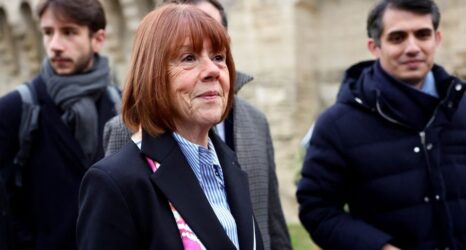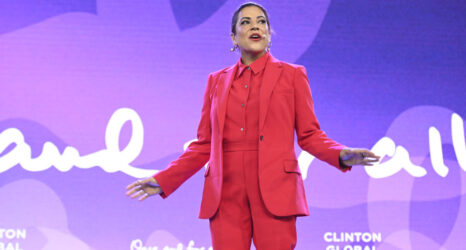In March, the Regeneron Science Talent Search in Washington, D.C. gave out top awards to innovative high school seniors challenging long assumed theories and societal norms. The competition, which stands as the oldest and most prestigious for students studying math and science in the United States, elevated 40 students out of the initial 1,800 applicants. With more girls in the top categories than years past, the young scientists were invited to meet with members of congress and display their projects at the National Museum of Women in the Arts.
“These students all share a deep curiosity about the world around them and a drive to improve it through STEM,” says Maya Ajmera, President and CEO of Society for Science & the Public. “We have admiration for their optimism: they see the world as it could be if a group of committed, thoughtful young people were to tackle some of our biggest challenges—which is exactly what they are doing.”
Ms. caught up with semi-finalists Natalia Orlovsky, Kavya Kopparapu and Nitya Parthasarathy to discuss their incredible projects—including artificial intelligence software that identifies gender-biased language, an assessment of the impact of vaping on lung cells from e-cigarettes and a new approach to reading cancer biopsies—and the importance of curiousity, diversity and good friends.
Tell me about your Regeneron project. What inspired you? Was there a specific problem you were trying to solve?
KK: [My project] was a kind of diagnosis for brain cancer biopsies. I asked: What genes are mutated and how can we take that information and use personalized treatment? I used a computational approach called “Deep Learning,” which means instead of telling a computer the steps, you teach a computer the steps to solve a problem.
NP: I created a program where anyone can put any document into it and it will give you a score between zero and one showing how biased it is. So for example, when looking at the sentence “he is strong,” if I took out the word “he,” a computer could evaluate whether “he” or “she” should go in there—which would mean there is bias. I started with gender bias, but it can also measure political or racial bias. My ultimate goal is to have a bias check the way we have spell check—so a purple line would appear and it would say, you have bias, so you’d have to change it.
NO: My project is a toxicological study looking at the effects of e-cigarettes. When I was doing my research in the summer of 2016, the FDA passed regulations on e-cigarettes being sold to minors. I had assumed e-cigarettes were unavailable to minors, and wondered about the adverse effects on cell survivors and the molecular explanations. I studied the ways normal cigarettes hurt cells and checked if electronic had similar effects. In some cases they did, and some they didn’t stress pathways and cause cells to die. So while we can say that they are safer than normal cigarettes, they probably aren’t completely safe.
Have you always loved science? Was there a moment early on that made you want to pursue it?
NP: My dad is an engineer, and he would bring home chips and computer pieces for me to look at when I was little. I also had a teacher in ninth grade who used to walk into every class and give us a problem. It would be something that was part of everyday life and somehow we never actually thought that science was related to it. But we’d jot down ideas trying to figure out what the lesson was. I later used this approach with my project and research; when I saw a problem that affected me and society, I wanted to know why. I think that’s the reason I chose STEM— everything in the world is so subjective. Doing something objective and logical really appealed to me.
KK: My parents introduced me to MythBusters when I was a kid. It taught me how to take something we see in every-day life, question it, design and experiment around it. Then in middle school, I first learned the building blocks of coding and was putting things together to make systems work. I realized I could apply it to anything so I learned Java, C++, all these programming languages—to the point that my mom would tell me to stop and eat, because I was so interested in it.
NO: I like asking questions. I don’t think I ever outgrew the “why?” phase some children have and now I do that in an academic setting. My mom is a scientist and father works with computers, so I had exposure to STEM at early age. Then I did a summer science program at the University of Pennsylvania. We got to design our own study around environmental questions that were more open ended without a pre-established correct answer. So I guess that’s what sealed the deal.
What did the Regeneron competition mean to you?
KK: I used to attend the Regeneron science fair as a kid and saw girls with really cool projects. I was amazed that this year I was the one with the project. We [finalists] come from different parts of the U.S. and different cultures and backgrounds. We do research in completely different areas—math, science, physics, computer science and biology—and learn from each other.
NO: It’s important from a social standpoint to have friends who also like to ask questions. You can bounce ideas off of people grow as a thinker and scientist. Science can be challenging; there are all sorts of road blocks. It’s really important to have a community that understands that and can support you.
NP: Something I have in common with the Regeneron girls is curiosity. Even after we went into judging, we would come out asking questions—not just to get the right answer, but because they wanted to understand what is happening in the world. Being able to work toward that with curiosity is productive and fruitful. It’s something we all share.
Do you think there are extra hurdles female scientists face? If so, what do you hope will change?
KK: I hope we make the field more inclusive. The barrier of entry shouldn’t be fear or alienation or feeling like you’re not good enough or don’t belong. My friends who are girls are usually the only ones in these classes. Like, there will be five girls out of thirty students, especially in advanced classes. It’s a lot of pressure to represent all the girls when you’re there.
NP: Only 26 percent of women actually go into this field—there’s a huge disparity. So that means that somewhere during the process girls are realizing that it’s not for them and it’s not because they’re not passionate about STEM. I think women have a really interesting way of looking at the world. Especially if you want to play into the stereotypes that girls and softer and more caring… I mean, that’s a wonderful perspective to bring into STEM.
NO: In my math class this fall, two out of 14 were female and there were a small amount of us in AP Physics. I don’t think that’s a failing of my school in particular, I think it’s a failing in the system overall to encourage young women. It was interesting to talk to other girls [at Regeneron] and see what their school situations were like and what mentor figures and factors had shaped their interest in science.
Is there advice you would like to offer girls interested in STEM?
NP: My advice is to never give up and find something that you’re passionate about. I’ve had so many people tell me that my project wasn’t good enough or I wasn’t good enough. You don’t even realize it when you’re a girl, you get used to people telling you that but it doesn’t have to be that way. I’m excited to see what girls do in the next ten to twenty years.
KK: One thing I’ve learned is that the worst thing that someone can say is no. And if they say no, you just pick yourself up and move on. In the scientific community everyone is super supportive in the interests of young students, so you’ll find some support. In terms of having the courage to start an idea, as young people we see what could be and how to make things better. I love adults, but I feel like adults in the science field have been there a long time. They think they know what is working or will work—we can question that.
NO: My advice to older kids is to remember there are a lot of resources and programs out there. There are university level labs and summer classes. To girls in general: remember to continue to ask questions. Don’t let anybody tell you that you can’t. There is nothing that makes young women any less able to ask and answer questions than young men.
Author’s Note: For high school girls interested in science, the finalists recommend Girls Computing League and Girls Who Code. The Society for Science & the Public’s STEM Action Grant Program also provides funding for many organizations that educate and empower young women to pursue STEM, including Black Girls Dive Foundation, Codella, Project CSGIRLS, Litas for Girls and Electric Girls.
Emily Sernaker is a writer and activist. She holds a MSc in Equality Studies from University College Dublin and currently studies Creative Writing at Pacific University. She lives in New York.





